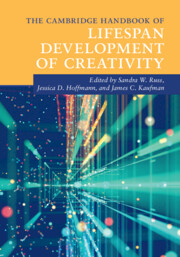Book contents
- The Cambridge Handbook of Lifespan Development of Creativity
- The Cambridge Handbook of Lifespan Development of Creativity
- Copyright page
- Dedication
- Contents
- Figures
- Tables
- Contributors
- Acknowledgments
- Introduction
- Part I Core Concepts of Lifespan Creativity Development
- 1 Basic Concepts of Creativity
- 2 The Creative Brain
- 3 Pretend Play
- 4 Creativity across the Lifespan
- Part II The Development of Creativity
- Part III Modes of Enhancement
- Part IV Environments and Contexts
- Part V Special Populations
- Index
- References
2 - The Creative Brain
A Developmental Snapshot
from Part I - Core Concepts of Lifespan Creativity Development
Published online by Cambridge University Press: 19 November 2021
- The Cambridge Handbook of Lifespan Development of Creativity
- The Cambridge Handbook of Lifespan Development of Creativity
- Copyright page
- Dedication
- Contents
- Figures
- Tables
- Contributors
- Acknowledgments
- Introduction
- Part I Core Concepts of Lifespan Creativity Development
- 1 Basic Concepts of Creativity
- 2 The Creative Brain
- 3 Pretend Play
- 4 Creativity across the Lifespan
- Part II The Development of Creativity
- Part III Modes of Enhancement
- Part IV Environments and Contexts
- Part V Special Populations
- Index
- References
Summary
Over the last two decades we have begun to gain some traction on the neural systems that underlie creative cognition in young adults. Specifically, neuroimaging experiments have revealed that creativity across several domains arises from the interaction of two large-scale systems in the brain: whereas the default mode network (DMN) is involved in the generation of novel ideas, the executive control network (ECN) exerts top-down regulation on the generative process to ensure the production of task-appropriate output. However, much less is known about the contributions of the DMN and the ECN – including specific structures within each network – to creative cognition at various time points throughout development. In this chapter I will review the nascent but growing cross-sectional literature on the neurological bases of creativity in the adolescent and the aging brain, which together with data from young adults provides a snapshot into the developmental bases of creativity across the lifespan. I will also outline avenues for future research in order to develop more sophisticated models of the developing creative brain, including investigations into the trajectory of change in the cerebral cortex, as well as the dynamics of synaptogenesis in relation to creativity.
- Type
- Chapter
- Information
- Publisher: Cambridge University PressPrint publication year: 2021



